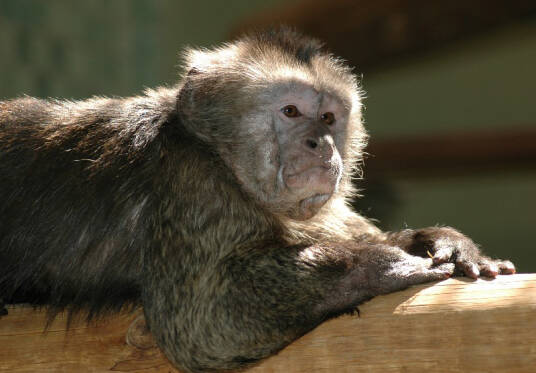Cebus olivaceus
IUCN
LCBasic Information
Scientific classification
- name:Cebus olivaceus
- Scientific Name:Cebus olivaceus, Guinan Weeper Capuchin、Wedge-capped Capuchin、 Weeper Capuchin,Sapajou pleurer, Capuchino Oliva, Brauner Kapuzineraffe, Wedge-capped Capuchin
- Outline:Primates
- Family:C.monkeys
Vital signs
- length:About 50 cm
- Weight:2.5-2.8kg
- lifetime:34-36, can live up to 55 years in captivity
Feature
There is a black to dark grey "wedge-shaped cap" that starts between the eyes and extends from the forehead back to the top of the head
Distribution and Habitat
Distributed in the Venezuelan Amazon Basin, starting from the upper Orinoco River, in the Orinoco savannah above the Rio Meta estuary, to the west and north to the Cordillera de la Costa and the Cordillera de la Costa of Venezuela, on the left bank of the Rio Essequibo in western Guyana, in the forests of the Guiana Shield. The distribution limits that separate the two subspecies are not well understood. In Brazil, they are restricted to the Rio Branco/Rio Alacá inter-river area in the states of Roraima and Amazonas.
Lives in savannah habitats typical of semi-deciduous dry tropical forests. They usually use the lower and middle floors of the forest to find food and escape predators. Shows a wide tolerance to habitat types.
Appearance
There is a black to dark grey "wedge-shaped cap" that starts between the eyes and extends from the forehead back to the top of the head
Details
Black-banded Capuchin (scientific name: Cebus olivaceus) English Guinan Weeper Capuchin, Wedge-capped Capuchin, Weeper Capuchin, French Sapajou pleurer, Spanish Capuchino Oliva, German Brauner Kapuzineraffe, no subspecies.

Black-banded capuchins are very social animals, living in groups of about 10-33 individuals. A group's home territory is about 25-40 hectares, but may exceed 100 hectares. These monkeys do not show territorial behavior in their mating system, but will compete with outside capuchin groups and other capuchin species for food and water resources.
A group of black-banded capuchins usually consists of 1 reproductively active adult male, some adult females and their offspring, and in some cases, non-breeding adult males. Juveniles usually make up about 50% of the group. Males migrate from their natal group when they mature, while females usually remain in the same group for almost their entire lives. Males usually leave their natal group between 3-6. Young males are rarely alone after leaving their natal group and quickly form a completely new group.
Black-banded capuchins mainly inhabit tall forests and travel long distances during the day. The primates usually wash sandy fruits and foods before consuming them. This behavior has been described as an example of primitive culture. Black-banded capuchins have been shown to clean sandy foods in 4 spontaneous incidents each in captive and wild populations. They use the forest floor and turn over leaf litter to find small vertebrates and invertebrates. They rub millipedes on their fur, especially during the rainy season, as a possible mosquito repellent technique. Capuchins appear to have a special affinity for millipedes that release a toxin that is thought to be a repellent for the capuchins. The monkeys rub the millipedes on their fur, often for up to two minutes at a time. In addition, they often put the millipedes in their mouths, take them away, and then rub them on their bodies. These capuchins often share these millipedes.
Foraging and dietary patterns of black-banded capuchins are related to group size and the season in which the animals are observed. Perceived predation risk is thought to play an important role in food intake patterns. Predation may also affect individual fitness, not only directly, but also through its effects on foraging success. They eat fruits, palm nuts, seeds, berries, and many species of small vertebrates and invertebrates. A strict hierarchy determines the priority of young capuchins in receiving food. Other foods may include buds, shoots, bark, gums, arachnids, bird eggs, and even other small mammals. Some coastal species may also include oysters, crabs, and other marine life.
Black-banded capuchins have a polygynous mating system. There is a dominant male who is responsible for mating with all the breeding females in the group. Males reach reproductive maturity at the age of 7 years, while females can reproduce in their fourth year. Mature females reproduce on average every 19 months, although it is not uncommon for females to give birth for several years in a row. Females give birth to one baby after a gestation period of 160 days. The baby weighs about 200-500 grams and can move around with its mother only shortly after birth, clinging to its fur. Females are the primary caregivers of infants, and males may spend some time foraging for females, but have little or no input in raising them. Allomaternal care, when females other than the toddler's mother help care for the infant, is common in black-banded capuchins. These monkeys exhibit many behaviors associated with allomaternal care, including nursing and carrying their infants. Infants are cared for entirely by their mothers for the first three months of life. Captive capuchins can live up to 55 years. The average lifespan of wild capuchins is 34-36 years.
The population of black-banded capuchins is considered stable, with a suspected decline of less than 10%. Habitat loss is the primary threat, but there is no evidence of a significant decline in the species.
Listed in the IUCN Red List of Threatened Species in 2015 ver3.1 - Least Concern (LC).
Listed in Appendix I, II and III of the Convention on International Trade in Endangered Species of Wild Fauna and Flora (CITES) 2019 edition Appendix II.
Protect wild animals and eliminate game.
Maintaining ecological balance is everyone's responsibility!








